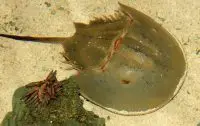Horseshoe crabs (Limulidae) are aquatic invertebrates. The ancestors of these crabs first appeared around 450 million years ago, which is why they are known as ‘living fossils’. They do not belong to crustaceans but the name of the subphylum is Chelicerata.
The four living species of horseshoe crabs are mangrove, Atlantic, Tachypleus gigas and Chinese or Japanese horseshoe crabs.
A hard carapace covers all of the crab’s body and mouth is present in the middle of the legs. It has five pairs of legs with a long tail, which can bring back the crab in case it tips over. The color of their blood is blue because of the presence of copper in their blood’s hemocyanin.
There are nearly 1,000 tiny units inside the two compound eyes of the horseshoe crabs. These units are known as ommatidia. The crab has two median eyes that can detect ultraviolet and visible lights; two ventral eyes next to the mouth and five eyes at the top of the carapace. Horseshoe crabs have the biggest rods and cones among animals and their size is hundred times bigger than ours.
Male crabs are sm aller in size in comparison to females. Atlantic horseshoe crab can be as long as 60 centimeters in length.
aller in size in comparison to females. Atlantic horseshoe crab can be as long as 60 centimeters in length.
They go toward shallow reefs for breeding. A female crab lays eggs in batches and may have 60,000 to 120,000 eggs in total. The eggs are hatched after 2 weeks.
They inhabit sandy bottoms in shallow coastal waters around the world’s oceans.
The diet of the horseshoe crabs consists mainly of mollusks and worms but also small fish and crustaceans.
One of the threats to the adult horseshoe crabs is that they are widely used as bait for fishing whelk and eels. Besides, their eggs are also eaten in Southeast Asia.





